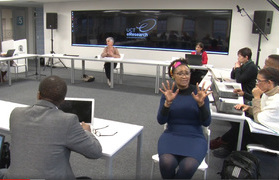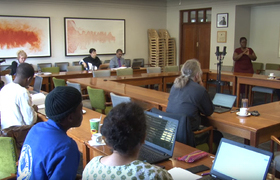The Place of Sara Baartman at UCT
20 March 2018 | BAC Womxn’s CollectiveThe views and opinions expressed here are solely those of the individual authors in their private capacity; they do not represent or reflect the views, opinions or policies of the University of Cape Town or the Communication and Marketing Department.
The label “Hottentot Venus” continues to haunt our memory of Sara Baartman. This moniker, used in Jean Reaux’s posters to advertise the exhibit of Sara, may have been repudiated by renowned scholars such as Pumla Dineo Gqola, Zine Magubane, Yvette Abrahams, Patricia Hill Collins, Sander Gilman among others, but it has persisted as the lens through which Sara’s story is seen. Her story “came down to us in history captured by the icon of the Hottentot Venus”[1]. Most images of Sara that we encounter today are derived from exaggerated prints and caricatured sketches such as those by William Heath, feeding into the sadistic frenzy of 19th century scientific racism. So ingrained has this incessant disgrace become, that being an accomplice in the pathological scrutiny of her body is regarded as civil. These images – reflecting the psychopathy of colonialism – are all there has been in piecing Sara’s story into a visual history.
The image of Sara at the University of Cape Town is part of a global predicament, but one that has to reckon with the violence of the visual images at our disposal and what they convey about those who consume them merely as objects.
In the year 2000, the South African artist Willie Bester unveiled his sculpture of Sara Baartman that was acquired by the University of Cape Town (UCT) for permanent display. Made from steel objects welded together, the sculpture depicting Sara with chains at her feet, is a life-size mechanical, machine-like figure. It is an assemblage of industrial debris, evoking a critique of the paradigms of scientific racism, but one that instrumentalises Sara’s body.
Bester had visited the Musée de l'Homme in Paris, where the plaster cast of Sara’s body and, separately, her skeleton was displayed. Many re-interpreted images, like this one, are based on caricatures and on the plaster cast of Sara, which was made by the scientist Georges Cuvier after he dissected her body for scientific study. Up until the 1970s, Sara’s remains were on display at the Musée de l'Homme but the display was removed after vigorous campaigns against the violation of her dignity as a specimen of study. Upon coming into office, Nelson Mandela’s request for the repatriation of Sara’s remains joins an already powerful feminist campaign. Diana Ferrus’ poem, I’ve come to take you home, underscores the significance of that collective call for Sara’s dignity, and by extension the dignity of all women, specifically black women. Sara’s remains were eventually returned in 2002.
So monumental and powerful was the return of Sara’s remains that a number of artists were engaging with the visual tropes of the “black venus” in relation to Sara as person. Artists such as Bongi Bengu, Senzeni Marasela, Tracey Rose and others re-envisioned the image of Sara in the contemporary visual landscape. And abroad, American artists such as Renee Cox referenced images of Sara to question the place of the Venus in the art historical canon, parodying iconic modern European ideological construction of the white Venus in relation to the representation of the black female body.
Sara’s presence at UCT is therefore not incidental, nor is it simply a sculpture made out of steel parts, rather it is the manifestation of the collective voice for dignity. Because of this, we cannot ignore that collective voice and social complexity that brings us to this point.
In 2015 and again in 2016 black womxn students collectively, through public ceremony, clothed her, with a kanga and head-wrap, to give Sara her dignity. By so doing, black students echoed earlier protests.
No doubt, the “dressing of Sara” has stimulated fresh debates about the representation of women in art on the university campus, but has been interpreted as censorship in one-sided, misinformed and sensationalist online articles in GroundUp.
Until recently (early 2018), Sara remained covered up. Then, as though a thief in the night, the UCT librarian William Daniels, removed the kanga and head-wrap. Missing the point about the so-called covering, he was applauded by the conservative corner at UCT. Daniels is hailed as a hero for insisting on the pathological obsession with naked black bodies in visual culture.
“Why would a white man see the need to derobe a sculpture in order to expose a naked Sarah Baartman yet again?” – this is the question that Professor Elewani Ramugondo asks. Is this not a question the ‘heroic’ Daniels should have asked himself, considering the historical and political complexity of Sara’s story, which this sculpture represents?
In his response, he stated that his removal of the kanga and head-wrap was not “disrobing” because only a person can be disrobed and “the sculpture is not a person… and it was not clothed, but covered up with cloth.”[2] While his comprehension of visual politics leaves much to be desired, the assertion that the sculpture should not be clothed because it is not a person, is simplistic. Firstly, artworks evoke ideas and memories beyond the “object”. Much like the way in which the term “Hottentot Venus” reduced Sara into a hypersexualised, fantasy object, the public assertions of those like Daniels bring us full circle back to looking at a representation of Sara and seeing a stark object, forgetting what it stands for. Secondly, it conflates the exaggerated deceitful narrative about artworks being systematically destroyed and censored at UCT, with a separate and considered engagement with an artwork. The Sara Baartman sculpture was not “covered from head to toe” as the photographer David Goldblatt claims (one wonders if he has actually seen it). Is it that difficult to tell the difference? The process of engaging this work is precisely to understand what it evokes as it stands at the entrance to the Science and Engineering section of the Main Library at UCT.
The impatient and impetuous action of removing the kanga and head-wrap has not only disrobed us but has robbed us of that much-needed space for multi-faceted debate and discussion. Daniels’ action, reflecting the intolerant attitudes in post-Apartheid South Africa, however, does demonstrate that the haunt of the “Hottentot Venus” continues to cloud our vision of Sara’s life.
We are trapped into a prosaic discussion about the object, as a sculpture, and as fine art that should be seen and displayed but never engaged with critically. And forget that Sara has become symbolic, representing a significant majority of women at UCT and beyond.
Taking the robes off so unceremoniously is to shame all of us, reminding us once again, how black women’s bodies easily become the repository for violent histories.
It is a particular kind of public shaming that is reminiscent of the violated spectacle that the black body has been and continues to be. bell hooks captures this in her definition of the sadistic public shaming of black women in her book: Ain’t I a Woman: Black Women and Feminism.
“Rape was not the only method used to terrorize and de-humanize black women. Sadistic floggings of naked black women were another method employed to strip the female slave of dignity. In the Victorian world where white women were religiously covering every body part, black women were daily stripped of their clothing and publically whipped. Slave owners were well aware that it added to the degradation and humiliation of female slaves for them to be forced to appear naked before male whippers and onlookers”[3]
This is intertwined with the pleasure of looking at that humiliation. The question arises: why was it so important to Daniels? What does it change for him personally? What has become overwhelmingly apparent is that although Daniels acted individually he has garnered so much support that it signals a terrifying social malaise. What does looking at the steel surface of the Sara Baartman sculpture reflect about those who want to continue to look at the representation of Sara as the Hottentot Venus? All this, in light of the fact that the rationale of dressing her up, and no indication of any intent to destroy the work, was clearly presented as a contemplation about Sara’s dignity, women’s dignity.
This, perhaps, is what has been troubling about responses from artists and art critics to this particular matter. That is, the canon of the Venus as the perpetual vulnerable nude, the fantasy object of male desire, the male gaze continues to normalise unutterable violence. For most interlocutors in the artworld, the object seems to matter more than the human tragedy it symbolises. It is not just a sculpture; it is not just a piece of cloth – it is centuries of trauma.
The prerogative of looking but not being seen characterises imperialist power. This is manifest in a number of absurd demonstrations of power (for example, the incident of the policing and harassment of women wearing burkinis on a beach by police in France) where women are stripped. To look at a clothed sculpture of Sara Baartman is perhaps the disruption of this sadistic pleasure of looking. It is to ask: what do you see when looking at Sara, not just as a sculpture but an intricate symbol? It asks us to question the Hottentot Venus-complex implicated in the looking and prodding of her naked body. The Sara Baartman sculpture at UCT mirrors the insistent violence on her body and until we listen to the collective voice calling for her dignity, we will forfeit the chance of understanding her significant place at UCT.
This piece was authored by a collective of black womxn academics at UCT under the banner of the BAC Womxn’s Collective.
[1] Crais, C. and Scully, P. 2009. Sara Baartman and the Hottentot Venus, Princeton, Oxford: Princeton University Press, Pg 1
[2] https://www.groundup.org.za/article/quarrel-over-sarah-baartman-sculpture-uct/
[3] hooks, b. 2015. Ain't I a Woman: Black Women and Feminism. New York and London: Routledge, Pg 37
 This work is licensed under a Creative Commons Attribution-NoDerivatives 4.0 International License.
This work is licensed under a Creative Commons Attribution-NoDerivatives 4.0 International License.
Please view the republishing articles page for more information.









